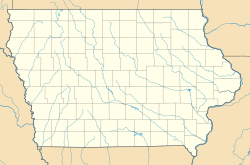Vander Veer Park Historic District: Difference between revisions
fix link |
add |
||
| Line 23: | Line 23: | ||
| refnum = 85000784<ref name="nris">{{cite web|url=http://www.nr.nps.gov/|title=National Register Information System|date=2009-03-13|work=National Register of Historic Places|publisher=National Park Service}}</ref> |
| refnum = 85000784<ref name="nris">{{cite web|url=http://www.nr.nps.gov/|title=National Register Information System|date=2009-03-13|work=National Register of Historic Places|publisher=National Park Service}}</ref> |
||
}} |
}} |
||
The '''Vander Veer Park Historic District''' is a [[historic district (United States)|historic district]] that was listed on the [[National Register of Historic Places]] in 1985. |
The '''Vander Veer Park Historic District''' is a [[historic district (United States)|historic district]] that was listed on the [[National Register of Historic Places]] in 1985. Over its 70.8 acre area, in 1985 it included 66 contributing buildings, 2 other contributing structures, one contributing site and one contributing object.<ref name=nris/> |
||
The historic district consists of houses surrounding [[Vander Veer Botanical Park|Vander Veer Park]]. The neighborhood is bounded on the north by Central Park Avenue, to the east by Brady Street, south by Lombard Street, and to the west by Harrison Street. The houses were built between 1895 and 1915 and are [[Queen Anne Style architecture|Queen Anne]] and [[Tudorbethan architecture|Tudor Revival]] style. The neighborhood is anchored on the south by a church and outing club. The park was originally the site of the Scott County Fairgrounds. Originally named [[Central Park]], the Vander Veer Park reflected the [[New York City]] park.<ref name=Book>{{cite book |title=Historic Preservation in Davenport, Iowa|author=Plan and Zoning Commission|month=December | year=1985}}</ref> The park was renamed Vander Veer after and early Davenport park commissioner. Development of the Vander Veer Park neighborhood was the first major beautification effort outside two small spaces in downtown. The beautiful atmosphere of the neighborhood is marred only by the density of traffic on Brady and Harrison Streets ([[US 61]]). |
|||
Over its 70.8 acre area, in 1985 it included 66 contributing buildings, 2 other contributing structures, one contributing site and one contributing object.<ref name=nris/> |
|||
==References== |
==References== |
||
Revision as of 20:51, 31 January 2010
Vander Veer Park Historic District | |
 Vander Veer Park houses looking across Harrison Street. | |
| Location | Roughly bounded by Temple Lane, W. Central Park Ave., Brady, High, and Harrison Sts., Davenport, Iowa |
|---|---|
| Area | 70.8 acres (28.7 ha) |
| Architect | Multiple |
| Architectural style | Late 19th And Early 20th Century American Movements, Late 19th And 20th Century Revivals, Late Victorian |
| MPS | Davenport MRA |
| NRHP reference No. | 85000784[1] |
| Added to NRHP | April 9, 1985 |
The Vander Veer Park Historic District is a historic district that was listed on the National Register of Historic Places in 1985. Over its 70.8 acre area, in 1985 it included 66 contributing buildings, 2 other contributing structures, one contributing site and one contributing object.[1]
The historic district consists of houses surrounding Vander Veer Park. The neighborhood is bounded on the north by Central Park Avenue, to the east by Brady Street, south by Lombard Street, and to the west by Harrison Street. The houses were built between 1895 and 1915 and are Queen Anne and Tudor Revival style. The neighborhood is anchored on the south by a church and outing club. The park was originally the site of the Scott County Fairgrounds. Originally named Central Park, the Vander Veer Park reflected the New York City park.[2] The park was renamed Vander Veer after and early Davenport park commissioner. Development of the Vander Veer Park neighborhood was the first major beautification effort outside two small spaces in downtown. The beautiful atmosphere of the neighborhood is marred only by the density of traffic on Brady and Harrison Streets (US 61).
